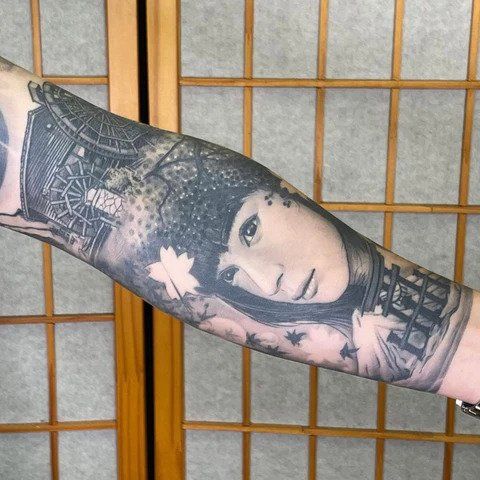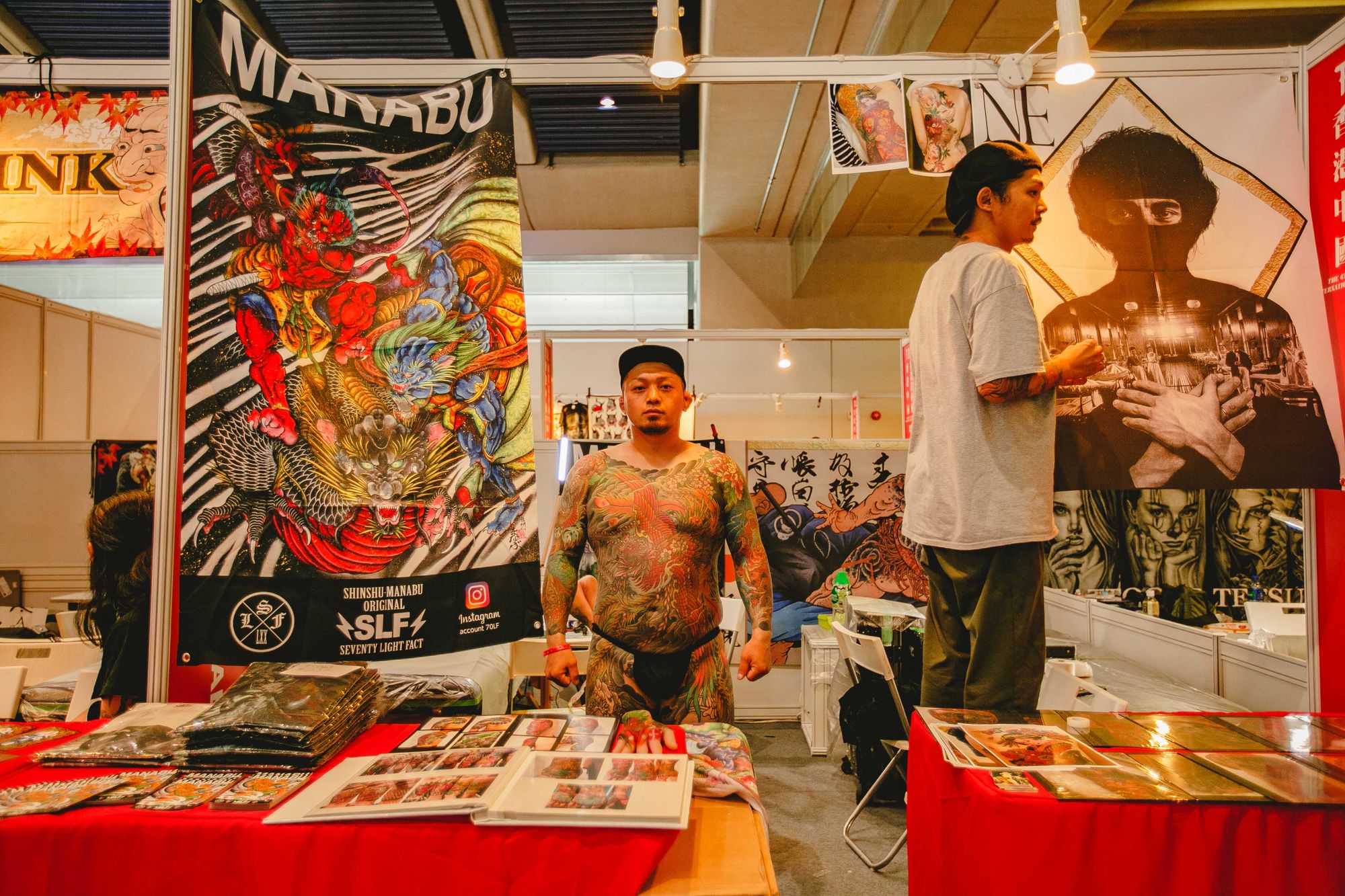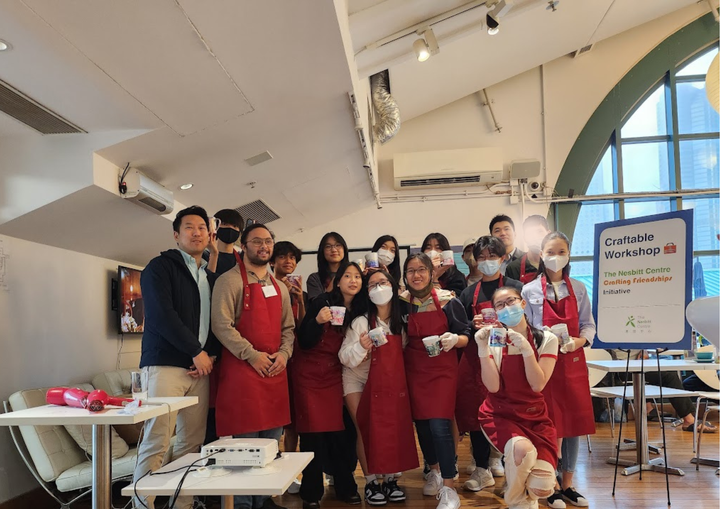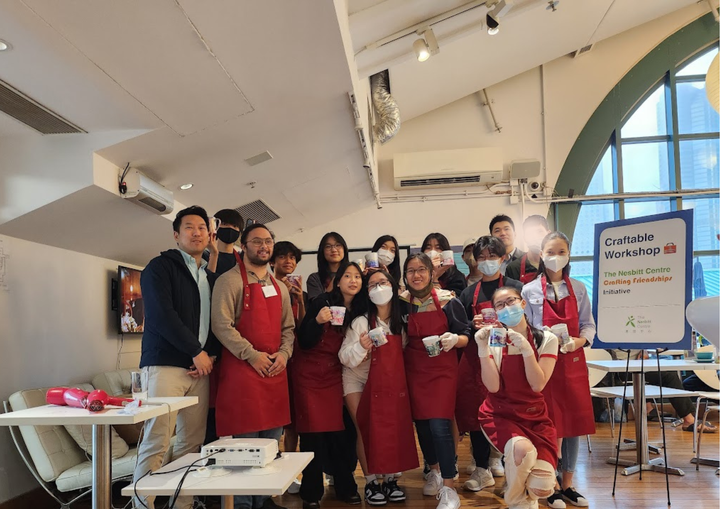It wasn’t until the age of 19, only six years after Gabe Shum’s first exposure to the world of inking skin, that he went pro.
Welcome to the Human Stories series by TMS, where we get to know Hong Kong through its many different faces. This week, we're speaking with Hong Kong tattoo artist Gabe Shum.
Hong Kong, mid-70s. A plane hovers between buildings as it makes a tactful landing on the runway of the famous Kai Tak Airport. Fleetline buses the color of fine sand, packed full of commuters, chug slowly up hills, engines struggling against the steep slopes of the industrial city. Neon signs advertising restaurants, dentists, optometrists, among many professions, bat-shaped symbols of pawn shops and barber poles hang above people’s heads as they hustle about their days.
Hawkers wearing dome-shaped hats roam the streets and call out, drawing people’s attention toward their snack stands. Wooden sampans lined with rubber tires bob on the fragrant harbor front, transporting goods and tourists clutching onto their Canon AE-1s. Amahs, wearing black trousers and Chinese collars, hurry along a busy street with young charges, their long braided pigtails trailing behind them like an impeccable shadow.
Merriment fills packed public housing complexes as families gather around the table every dinner time to watch popular TV dramas that have just been aired. “Enjoy yourself tonight” on TVB Jade comes on even later at night to everyone's delight, and children stay up, sneaking glances at the TV sets from around corners of their living room. Aunties stay busy sitting in corridors, throwing money down, mahjong tiles cracking against each other. In the distance, Tom Jones and the Eagles are heard over passing radio stations.
A 13-year-old Gabe Shum follows his friends to a tattoo shop in Tsim Sha Tsui out of fascination and curiosity. He enters. Photos of the artist’s pieces are displayed on the wall like trophies, and the air is thick with the sound of the tattoo gun gripped between the artist’s fingers. A cam chain click and clatter like the exhaust of a vintage motorcycle. The young Shum is instantly captivated.
An impression inked deep
“My dad was a bike racer,” Shum reminisces with an enthusiastic smile on his face. “So since I was a kid, I would always watch my dad ride his bike, repair his bike, and that’s why I’m a big fan. I’m a bike rider, too.” The buzzing of the double-coiled tattoo gun – akin to a miniature motorbike – is his origin story of how he fell in love with the art of inking after all.
But that is not the only paternal-related interest that’s engrained in Shum’s DNA. “My dad was a painter, so he drew a lot. So when I was a kid, I would watch my dad draw, and he would teach me how to draw. So, actually I draw pretty well,” he says affectionately.
However, although heavily inspired by his father’s interests and activities, he wasn’t always so supportive of the art form. “When I was young, my dad kept telling me – dont make any tattoo. Because if you make a tattoo, it means you’re a triad member, or a gangster, mafia, something like that,” he recalls. The comment confused Shum, who, in his curiosity, wanted to know more about where this idea came from. So, he bounced from library to library, researching about inking’s past. “I didn’t find any evidence that tattoos belong to any syndicate or any gang or group,” he affirms. That was a green light to pursue his passion.
The first time Shum ever picked up a tattoo gun, he was only 16. Due to a mishap consisting of a friend receiving a wonky tattoo of a lion’s head, another friend suggested Shum give tattooing a shot instead. In preparation, he headed to a connected friend’s brother, who was a tattoo artist, and asked him to teach him how to set up the machine, as well as if he could borrow it for the event.
The tattoo was of a mermaid that he designed and subsequently tattooed on his friend’s leg. The mermaid was an absolute success. Through a natural feeling for the craft, word of mouth and giving out multiple free tattoos, Shum got more and more practice in the art. And he started to build up a following of clients.
A challenging scene

It wasn’t until the age of 19, only six years after Shum’s first exposure to the world of inking skin, that he went pro. “At the time, it was very tough,” Shum explains when asked about how a tattoo artist would work on improving their craft back in the day. From using pig skin to orange peels, tattoo artists would practice on the most skin-like materials they could find in order to hone their skills. But he credits his little brother’s friend’s older brother for teaching him and setting him up to become the professional that he is today.
“In those days, even if I wanted to look for a tattoo magazine, it wasn’t that easy,” Shum recalls. So, he did the next best thing – he grabbed a backpack and headed to Europe in search of more experience. He flashes a humble smile as he remembers the many times he would be kicked out of tattoo stores, explaining that tattoo artists were much more cautious back then. It was thanks to Shum’s ability to draw beautiful renditions of dragons that his artwork was noticed by a friend who subsequently invited him to design flash tattoos.
When Shum first opened his shop in Hong Kong, there were only four tattoo shops in the city. Now there are over 300. “You have to chase. You have to keep encouraging yourself. Keep practicing and practicing,” Shum says. He delves into the intricacies of tattooing back in the day and how the technology has changed over the years. From mixing their own ink to sealing their own needles, the scene was drastically different in the 80s. Now, with new tools in the market, the tattoo scene has developed a lot. Rotary guns have replaced the double coil guns; the machines are soundless, and the inks are premixed. But one thing remains the same – the passion.
“I put a lot of passion,” he explains. When other people around were going out and partying, he would stay in his shop practicing. He does point out the futility of going into the tattoo artist career if a person isn't fueled by the love of the craft. In short, it can’t just be treated like any other job. “If a person really loves to become a tattoo artist, the first thing is that they need to have a huge passion. And that passion is going to keep you moving, chasing, learning,” he says.
The artistic process
When asked how he developed his own style of tattoos, Shum explains that style is ever-changing. And to give us an idea, he goes through many of the different tattoo styles one may encounter. “Tattoo, there is no limit – just like art. Like kung fu, like martial arts – we have Wing Chun, we have karate and judo … nowadays we have a lot of new artists coming up. We have traditional style, tribal style, color realistic and dark side, ” he reveals. “If you are a proper tattoo artist, you need to learn a lot. You have to change. You have to practice …You need to have a strong creative mind.” Learning and developing is a constant in his line of work, and being able to shift and innovate is of utmost importance.
“Mostly, they know what they want and what tattoo they want to make, and that’s how we start to discuss,” Shum says when describing his client-focused artistic process. However, he admits that he does occasionally come across clients who have no idea what they want and want a tattoo just for the sake of having one. He strongly encourages them first to have an idea and mainly to answer the question, “Why? Why the tattoo?”
“Each piece of work gives us a memory,” he emphasizes. “It’s not just for fashion.”
But although Shum is open and happy to work with clients and accommodate their requests, there are three things on which he has clear boundaries set. “I don’t do face tattoos,” he says. “Because that is for the respect for my client’s parents.” His restrictions also include no nazi symbols and no meaningless tattoos.
Ending the stigma

Although tattoos are becoming increasingly prevalent, Shum still finds himself fighting for the end of their stigmatization with the primary message – that tattoos are art. “Give a little space for tattoo artists,” he says. Tattoo artists are always on a mission to persuade and let people know that they are artists, not gangsters. He emphasizes the importance of artists focusing on their passion and becoming outstanding at their craft.
As part of his mission to end stigma, Shum created the Hong Kong China International Tattoo Exhibition, presented by Shum’s own shop, Freedom Tattoo HK. Starting in 2013, the exhibition is currently in its seventh year, and he’s proud to say that in this time and age, it’s one of the best in the world. Contrasting with other conventions, tattoo conventions have their focus on inviting and persuading tattoo artists to join. And that is no easy feat. As Shum explains, there is a huge element of trust when it comes to the artist deciding to join.
Shum mentions that throughout the years, he has seen conventions popping up in an increasing amount of locations around the world. So, he naturally thought that Hong Kong, being the beautiful cosmopolitan city that it is, should have its own as well. “The purpose of doing a convention is to teach the people that tattoos do not belong to gangsters, first of all,” he insists.

This year, the Hong Kong China Tattoo Exhibition will take place at the Hong Kong Convention Center from August 25 to 27. They are expecting up to 160 artists to participate, and although Shum admits that this is fewer in comparison to some of the previous events, he is still delighted as this is the first convention since the break they took during the pandemic.
He stresses the importance of the younger generation of tattoo artists being able to mingle with each other, share knowledge and discover new technologies of the craft. “We want to let other overseas artists come down to Hong Kong and see what is happening in Hong Kong, how the industry is doing now,” he says. And where else to do it than one of the world’s most popular tattoo conventions?
But the Exhibition is not only for tattoo enthusiasts. He encourages people to bring their parents, loved ones and even those who may not be so open to the tattooing world. “That’s why we need a good tattoo convention,” he says. "To bring them in. To let them know what we are doing. I’ve always said tattoos should be a happy thing.”





Comments ()